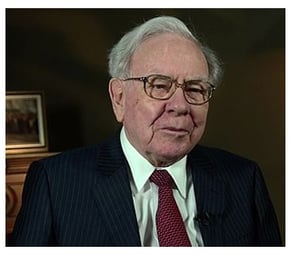Chief Conclusion
Warren Buffett shows his mastery of investing through his simple description of it. Simpler is often better in investing. Never let anyone tell you differently.
This is the second in a two part series on what we can learn from the world’s best investors about identifying great investments. The first explored Charlie Munger of Berkshire Hathaway and his inversion principle. Mr. Munger’s emphasis was not on how to be brilliant but rather how not to be stupid.
His counsel to avoid big, stupid mistakes is the same advice I received from Jim Dunton, Capital Group’s deeply respected and highly experienced senior portfolio manager back in the summer of 1999. The roots of our own team’s investment philosophy of “winning by not losing” run deep and are shared by experienced investors that have earned our respect.
Still though, I was a bit daunted when I thought about delivering on the task I had laid out for myself this week, to summarize in this final part of a two-part series my own conclusions on the most important aspects of successful investing. How could I possibly cram two decades of my own constant study and experience into just a few lines? Much less everything I had learned from so many others?
Happily, the solution presented itself serendipitously, as so often happens in investing and in life. The answer was to draw upon what I learned from the time I met legendary investor Warren Buffett, many years ago.
 Warren Buffett is clearly not only one of the world’s most successful investors but also one of the most generous in sharing his knowledge. I had the good fortune to meet him many years ago when he came to Philadelphia to speak to the University of Pennsylvania’s Wharton School of Business. I remember to this day his concise explanation for how he thought about investing, which I am happy to share with you.
Warren Buffett is clearly not only one of the world’s most successful investors but also one of the most generous in sharing his knowledge. I had the good fortune to meet him many years ago when he came to Philadelphia to speak to the University of Pennsylvania’s Wharton School of Business. I remember to this day his concise explanation for how he thought about investing, which I am happy to share with you.
What I Learned from Warren Buffett
I am sure Mr. Buffett would not remember meeting me. It was a long time ago. Frankly, I can’t even remember whether it was 1999 or 2000 when he came to campus. But I do remember the beautiful simplicity with which he described investing. It was like watching Tiger Woods swing a golf-club. He made something devilishly complex sound easy.
I was the first in line at the Annenberg Center that day eagerly waiting to take my seat among my fellow students who packed the 936 seat Annenberg Theatre to hear him speak. After the proper introductions, they opened the floor to questions for Mr. Buffett. For once the famously competitive Wharton student body hesitated, so I asked the first question. After welcoming him to campus and thanking him for his time, I asked him to summarize how he thought about investing. This is what he told me:
The Castle and Its Moat
The kinds of businesses in which he seeks to invest are what he calls “castles.” These are strong economic fortresses whose robust financial characteristics reflect the strength of the business. You often hear investors describe such businesses as those with high returns on capital and lots of free cash flow. But its not enough that the business has fundamentals that are extraordinary today. The very best and most rare of investments will retain these characteristics for many years, thanks to what Mr. Buffett calls a “durable competitive advantage.” That is really the hard part.
For these businesses, these castles, to remain protected for many years they must be protected from the forces of capitalism’s creative destruction, the powerful force behind much of the world’s material progress in delivering goods and services better/faster/cheaper. These forces of competition constantly innovate, seeking to overwhelm competitors and overthrow today’s most profitable businesses. The only protection against these forces, is what Mr. Buffett called a durable competitive advantage, or, in other words, a moat. Different castles can and do have different kinds of moats. But should a castle’s moat ever fail to protect it, the castle may fall, and with it the castle’s, i.e., the company’s value.
Buffett on Castles and Moats: In his Own Words
You can literally read hundreds of books and watch thousands of hours of video worth of material on Mr. Buffett’s investing. After much reflection, I believe that the video of Mr. Buffett below explains in literally two minutes how he thinks about investing, in the simple terms I used above, that I first heard from him almost twenty years ago.
There you have it! The two-minute explanation of how one of the world’s best investors does his job. One of my favorite quotes has always been from Einstein, who famously said “You don’t really understand something unless you can explain it to your grandmother.” So, I have a deep appreciation for the profound simplicity with which Mr. Buffett explains his views on such a complex subject.
In Conclusion
“Trends and Tail Risks” is both an active journal of our team’s decision-making in the markets as well as an opportunity to summarize and reflect on what we have learned from our own investing journey. Most of the time these pages are devoted to deeper dives on more complex fundamental topics, such as analyzing individual investments or timeless principles such as cycles, replacement cost investing or the role of microeconomics. But there is always value in revisiting the core of what we are really trying to do, which is to identify castles that are well-protected by moats.
We chronicle in these pages the many different places to which we are drawn in our own quest for what we think are the world’s best investments. But the constant throughout is the huge debt that we owe those who have walked these paths before us, who have added to our own hard-fought twenty years of investing experience the lessons of their journey.
I do hope that in some small way these pages contribute to our collective knowledge of investing and may begin to chip away at the burden of our debts we owe to those from whom we have learned so much.•
Sources: Warren Buffett, Wikipedia

